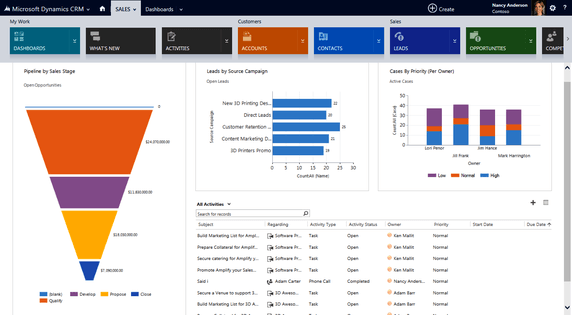
New leads can find your business through a variety of marketing channels: paid search, a content-optimized blog, word of mouth, email opt-in forms, and social media are common inbound lead generation tools.
One company defines an inbound lead as “a person who approaches your company with the intent of learning more about and potentially buying your product or service.”
While inbound and outbound lead generation are both important components of your marketing strategy, we’ll be focusing on helping you optimize your inbound lead approach.
What’s the Difference Between Outbound and Inbound Leads?
Inbound leads are distinct from outbound leads, also called interruption marketing, which are leads directly approached by your company through cold-calling or emailing. Outbound lead generation strategies were originally modeled on traditional door-to-door sales practices.

An easy way to remember the difference between inbound and outbound leads: inbound leads come “in” to your business, whereas you have to go “out” to find outbound leads.
Marketing agencies are shifting their focus and spending from outbound to inbound tactics. One recent survey revealed that sampled marketers spent 23% of their overall budget on outbound marketing and 34% on inbound marketing.
Overall, inbound marketing tends to be less expensive than outbound, especially over time. That same survey indicated that on average, inbound leads cost 61% less than outbound, and the average cost-per-lead drops a whopping 80% “after 5 months of consistent inbound marketing.”
Examples of Inbound Leads
Most inbound lead generation tools rely upon creating high-quality, optimized content that attracts new leads.
Successful inbound lead generation is all about attracting the right attention. To quote marketing guru David Meerman Scott:
"It’s no longer about pitching The Today Show. It’s about creating content that will attract The Today Show."
With a wealth of options, your targeted audience needs something specifically intriguing or unique about your brand. With that in mind, here are some common categories of inbound leads:
SEO
In most cases, customers reveal exactly what they’re looking for through their search engines. By optimizing your site’s SEO, Google’s crawlers will index your site as relevant for certain topics that directly correlate to your customers’ searches.
This is crucial for your inbound lead generation strategy, because 33% of lead traffic goes to the highest-ranking Google result while only 17% goes to the second-ranked listing.

Using a simple SEO audit tool is one of the most cost-effective ways to optimize your website for inbound leads.
Blogs
Blogs are a key way most companies generate traffic to their site to create inbound leads. Blogs should always be SEO optimized (see above) to ensure a match between searchers and your content.
High-quality blogs position your brand as an authority on a topic, making leads more likely to become customers.
B2C blogs are crucial for cultivating inbound leads: 68% of inbound purchasers read content from brands they follow.
Blogs are also important for B2B companies; however, these customers are interested in even more detail and high-authority content, so B2B content strategy should also include white papers and eBooks.
Email Opt-Ins
Email opt-ins take several forms:
- Subscribe to daily/weekly newsletters
- Download a free product (usually some kind of guide)
- Game, quiz, or something else entertaining
Email opt-ins don’t need to be flashy, but they should be present throughout your site. It also helps when they include an incentive, like a free guide or a 3-minute quiz. This should be attention-getting. Email opt-in forms should be attached to any lead magnets you have on your site, like a free template if you’re a design company or a free sample for beauty brands.

Once inbound leads enter their email addresses, the company can then send them targeted content and offers that interest them, eventually leading to a sale.
Social Media
Most successful inbound lead generation campaigns begin with specifying a target audience, and this is especially true of social media. You will likely need some paid ads to gain new followers and it's important to know which platform to invest in.
For example, the latest social media demographic research indicates that Facebook is still the leader among most age groups with YouTube very close in terms of monthly active users.
Inbound lead generation in a social media context really relates to organic social (ie: publishing content on social without paid advertising). But you may have heard some marketers saying social media is now "pay to play". While organic reach has been falling, some organizations still receive excellent levels of organic reach (30, 40 even 50% or higher) on their content.
Organic reach is definitely not dead on social. You just need to measure what your current organic reach rate is and analyze what kind of content gets better organic reach than others.
How to Get More Inbound Leads
While all the tools we listed above are individually useful, the ideal strategy is to systematize all of your inbound lead generation techniques.
For example, you can think of your lead generation as a flow that starts with content.
- Publish SEO-optimized content to your blog and website
- Optimize your content for social sharing and link content back to your site
- Integrate lead magnets (free downloads, special events, giveaways) into your site
- Add email opt-in forms to your site
- Channel all opt-ins and user-generated info into a Customer Relationship Management (CRM) tool
- Use your CRM tool to send specifically targeted content to your leads

Ideally, this flow should create a reinforced loop that begins and ends with good content. You attract customers to your site by generating content and making it easy to find. Make it easy for leads to express interest and volunteer an email address or follow your social channels by offering high-value lead magnets attached to email opt-in forms. With this information, you can then specifically target them with content optimized to their interests.
Over time, this will help you build a customer base of leads who trust your brand’s opinion and seek it out for recommendations before making purchases.
Outbound Vs. Inbound Lead: Pros and Cons of Each
While outbound marketing (TV ads, cold calling) was a centerpiece of traditional marketing practices, today 32% of brands are decreasing spending in order to increase spending on their content marketing strategy.
We’ll explain some of the pros and cons of inbound marketing over outbound.
Outbound Leads: Pros and Cons
While outbound leads can make a marketing team feel more proactive, they can be more expensive and less effective in the long run.
Pros:
- Familiar formats – commercials, ads, cold-calling
- Shortened sales cycle - you can get a yes or no right away
- Immediate feedback from leads and sales team
Cons:
- Generates fewer than 10% of clicks online
- Costs remain static over time
- Negative association with junk mail, telemarketers
- Rise in blocking/ad skipping technology
- At least 61% more expensive than inbound lead generation
Inbound Leads: Pros and Cons
Inbound lead campaigns are proven to provide a higher ROI when executed correctly. One study concluded that inbound marketing had a lead conversion rate 30 times higher than outbound marketing.

Pros:
- More leads – up to 3 times more than outbound marketing
- Diminishing cost per lead over time
- Better customer experience – 82% of customers enjoy reading relevant content from brands
- Easier to track ROI
- Better lead segmentation
Cons:
- Potentially many channels to manage
- Longer sales cycle
- Must be tied to analytics for assessment
We can see that a successful strategy for generating inbound leads relies mostly on specific, targeted goals, some patience, and a good tracking system.
3 Creative Inbound Lead Generation Ideas
In an increasingly crowded digital landscape, how do you get your content to stand out and attract an inbound lead? Here are three of our favorite ideas to get your started.
1. Optimize SEO
This is foundational to generating inbound leads because SEO is what boosts a site’s SERP (Search Engine Result Page) rankings and helps an inbound lead find your site, rather than a competitor’s, when conducting a search.

You don’t need to painstakingly rewrite each section of your website, though. You can use a simple SEO audit and reporting tool like SEOptimer to determine which areas of your site need to be optimized.
2. Podcasts
According to Racheal Cook in Forbes:
"Podcast listeners are extremely engaged and loyal to their favorite shows, often listening to six hours or more of podcasts per week. It's also a huge reason to host your own podcast!"
While podcasts take time to produce, they are relatively inexpensive to create. They can be a good source of inbound leads for niche businesses with a small but dedicated following.
3. Chatbots
One of the main difficulties of managing inbound leads is the person-hours load that can take. Chatbots can handle some basic initial inquiries, which frees up time for your human staff. This also allows a new lead to interact with a new company on their own terms, just by clicking on a Facebook or Instagram ad, without worrying that they will be trapped in a lengthy sales conversation.
Larry Kim, Founder of MobileMonkey says chatbots are one of the most cost-effective ways to help generate leads and nurture prospects.
"Chatbots can be used in a whole range of lead generation marketing tactics such as drip campaigns on specific channels like Facebook and Instagram or sophisticated omnichat marketing."
The Bottom Line
Inbound leads are invaluable, because they represent potential customers who are actively trying to find what you are selling. Optimizing your web content to generate more inbound leads is a great way to nurture new growth.
Let us know on Twitter @seoptimer what inbound lead generation strategies are working for you.










